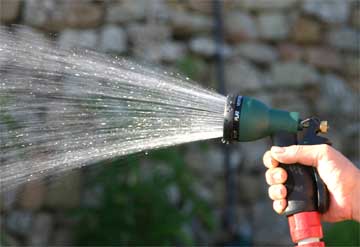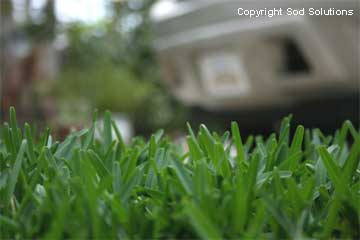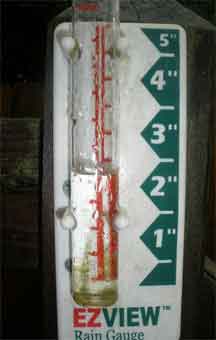Summary: Lawn Watering and Irrigation – it is a subject with much discussion. In this article we’ll break the lawn watering topic into smaller bit size pieces to help you develop a watering program for your lawn that works.
Lawn watering, it’s the subject of lots of questions. It should come as no surprise. The topic of plant watering generally is popular, and without water, a lawn will not survive.
Let’s get started…
It would be great if you could use a checklist or push a button to know exactly how much, how often and when to water the lawn. The problem is, the requirements in lawn watering has so many variables.
Variables such as:
- Soil Type
- Grass type
- Climate
- Maintenance schedule
- Irrigation equipment
- Temperature
- Wind
- Humidity
- Drought-tolerant plants
There are some guidelines for watering lawns, but the best understanding of how to water your lawn will come by learning and experience with your grass.
Many watering questions get answered when you understand…
- Your lawn
- Your climatic conditions
- Any possible water restrictions
- How the lawn reacts to water, the weather, drainage and fertilizer
- How your irrigation system works
Guidelines, checklist and an underground irrigation installation are wonderful tools, but a successful lawn watering program comes down to you – the “supervisor of watering.” Read on to learn more about best lawn watering schedule.

How Often Should A Lawn Be Watered?
Probably the #1 question asked is – How often should I water my lawn?
Not to be sarcastic, but the answer is pretty simple – proper lawn care means needing water when it needs it. This comes before the grass wilts and the soil starts to dry out. Before that blue-green color appears and foot prints show and the grass does not bounce back. However, let’s look a little deeper.
We often receive questions like this:
We recently installed a lawn sprinkler system and need a few watering tips. We have an irrigation controller and watering timer and need to set up the lawn watering schedule and zone frequency for watering the lawn. Can you give some guidelines? Art, Burke, VA
Answer: Art, the best lawn watering advice I can provide is to – Water when necessary.
Grass does not require daily, weekly or monthly watering. This is not to say you should never water the lawn.
During periods of hot weather and drought you will most likely need to turn on the sprinkler system to supply some water to the lawn that nature does not supply. But, it is best to water when the grass and lawn needs it and when watering… give it a very thorough soaking.
How Can You Tell When Grass Is “Thirsty”?
You tell grass is “thirsty” and in need of water – When it starts to wilt OR When the soil is dry.

During dry weather or exceptionally hot times, do some visual checking to see if the grass is wilting. When the grass begins to get limp or looking tired, apply water or flip on the irrigation system. Another good soil test is to do a quick “soil moisture test.” Take something like a knife and push the blade into the soil 5 -6 inches. If the grass blades come out shiny and dry… it is time to water.
2 Rules of Lawn Watering
When watering a lawn there are 2 simple, basic rules to follow:
- When you water the lawn – water it thoroughly. This means soaking the ground and soil to a depth of about 4-6 inches
- Only apply water as fast as the ground can absorb it
The only time a lawn needs a “light sprinkling” is when lawn seed is first put down.
Giving a light sprinkling to an established lawn only encourages the grasses root system to develop near the surface. Thorough and deep watering helps the root system to push down deeper and develop stronger grass roots.
The “deeper root system” allows the grass to absorb more water and nutrients. A deep rooted lawn is usually a healthy lawn can better withstand seasons of drought. Where a shallow rooted grass will fade when tested by weather extremes.
The Job of Lawn Watering
Watering the lawn should be a simple task. With so many sprinklers on the market and flip of a switch or turn of a value should be the only effort required.
Sprinkler heads make the task of lawn watering simple, efficient and effective.
Sprinkler heads allow water to be applied only as fast as it can soak into the ground.
When setting up your lawn watering zones, I would first run everything manually. You want to put down about 1 inch of water per hour as that is about what most soils can adsorb in 1 hour’s time.
To determine how much water is actually being applied, put down cans in the sprinkler’s water pattern to catch the water and see how much is applied in 1 hour.
Then make the adjustments and set your lawn watering schedule and frequency for each zone so that each watering zone gets no more than 1 inch of water per hour, which should moisten the soil to a depth of 3 – 4 inches. To thoroughly water the sprinklers may need to be run in each zone for about 2 hours.
Avoid all flooding.
What we mean by the term “flooding” is when water is applied so fast that the water runs off the grass. Some would suggest this would be considered “thoroughly watered” but it is not. The soil can only “drink up” water so fast depending on the soil make up. Excess water runs off and is wasted.
To be successful in lawn watering just remember the 2 rules: When you water the lawn – water it thoroughly and only apply water as fast as the ground can absorb it.
How Long Between Waterings?
The length of time your lawn and any other lawn can go between watering comes down to several factors.
- Water
- Soil Conditions
- Grass Type
- Weather
Water and Grass Root Systems
When lawns are watered frequently with short irrigation cycles, water only percolates down possibly an inch or two from the top. Roots seek water and will only grow where water is available.

Frequent, short watering cycles produce a shallow root system, limited in size.
This results in “building” a lawn with a shallow root system and one requiring the lawn to be watered more often.
More frequent lawn watering keeps the grass surface wet and more susceptible to turf diseases like fungus. It also creates and ideal environment for weeds to flourish.
A root system that runs deep (6 inches or more) has a much stronger foundation. This deep root system can “pull” moisture from a much larger area, handle heat stress and go longer between watering cycles.
Soil Conditions and Watering Lawns
Soil conditions and types play a role as well in the amount of water required when watering.
A clay soil generally holds about 2 times as much water as a loam soil, and a sandy soil holds about ½ as much as the loamy soil.
Translation: Lawns maintained in sandy soils need irrigation more often than a lawn growing in a rich loam. Clay soils need which hold the most water need the lawn watered less often and to avoid run off water should be supplied slower.
Grass Type and Watering Lawns
Grass is a plant. Like all plants each type of grass has its own water requirements. Knowing the type of grass in your lawn will affect your frequency of irrigation.
Local Weather and Watering Lawns
Your geographical location and local weather patterns influence lawn watering schedules and programs. Seasonal rain, hot summers, wind or windy location help determine the frequency of required irrigation.
Water is not the only factor in grass staying green. Do not forget that some grasses go dormant depending on the season and grass type.
Cool season grass like bluegrass does not like heat and goes dormant during the summer. St Augustine grass does not like the cold and will go dormant during the winter.
Rules For Drought Conditions and Lawn Watering
One State Extension Service had this comment on lawn watering and drought: “If your lawn will not survive an ordinary drought without watering, it probably needs rebuilding.”
- When drought conditions exist do not apply lawn fertilizer
- Allow grass to grow higher before mowing, and mow less often
- Reduce weed competition allows weeds to become established
- Irrigate turf when grass needs or shows signs of needing water. Water to a depth of 6 – 8 inches where the root zone is. Do not water to runoff.
When setting up a watering program for your lawn, rain gauges are very helpful. Tracking the amount of rain fall can help in planning or adjusting irrigation schedules. Just an FYI… Drizzles do not supply very much soil moisture.
However, irrigating after a light rain can help reduce water use. Before turning on your sprinkler system, make sure your community is not under water restrictions or irrigation can only run during specific hours or days.
How Much Water Does A Lawn Need?
We’ve hinted a few times in this article on – How much water a lawn needs?
A healthy deep grass root system reaches down to 6 – 8 inches. About 1 inch of water on the surface of your lawn should allow the soil to be moist to the 6-8 inch depth.
During dry periods, a healthy root system would deplete this moisture reservoir in about 3 days.
When applying water to a lawn… uniformly is key. Do not apply irrigation faster than the lawn’s soil can absorb the water. Watch out for runoff during irrigation – runoff is wasteful. To reduce runoff, divide irrigation times into 2 sessions, wait 20-30 minutes between sessions to allow the water to percolate into the soil, then continue the irrigation cycle.
When Is The Best Time To Water The Lawn?
There are many thoughts on the topic of the best time for lawn watering. Some argue that watering the lawn during late afternoon is best.
Afternoon watering does have some drawbacks.
- Evaporation from the sun and wind is greatest during the afternoon hours.
- Evaporation means less water applied to the lawn.
- Unless an irrigation pump has been installed, sprinkler systems connected to a local water supply often experience lower water pressure during afternoon periods.
- Winds can change sprinkler coverage by impeding watering distribution patterns.
- Heat and wind can make grass appear stressed
Some believe watering during evening hours is the best lawn watering time.
Others argue that grass staying moist during the night from an evening watering session promotes disease.
Disease prevention comes down more to cultural practices: fertilizing, mowing and dethatching – rather than night or afternoon watering.
Grass becomes wet or damp at night naturally from dew. So the disease debate will continue to go back and forth.
If you believe late afternoon or evening irrigation cycles will increase the chances to disease on your lawn, begin watering your lawn early in the morning.
In my opinion, early morning is the best time to water your lawn – but only WHEN your grass needs water.
Watering New Lawns
New Lawns – this is defined as a lawn newly sodded, newly seeded or sprigged.
Watering rules for a “new lawn” are different.
Deep watering should be done on established lawns. New lawns with germinating seeds, or newly laid sod with tender roots beginning to stretch and venture into the soil need extra moisture. Sometimes, a good sprinkling on grass seed is required more than once per day. On new lawns… daily irrigation is a regular task for the first 30 days.
Irrigation Equipment
We’ve been discussing lawn watering throughout this article. We’ve stressed the importance of “knowing” your lawn.
However, “knowing” your irrigation equipment, its design – portable, installed underground (more accurate, uniform and predictable application rates than portable), drip, timers, controllers, zones, rates water is applied and how the system all works to deliver the water is just as important.
Without knowing your irrigation system and its limits, areas of the lawn can be over and under watered contributing to other potential issues – weeds and/or disease for example.
Measuring Water Distribution
In order to calculate how much water your sprinkler(s) or irrigation system puts out, the water output of individual sprinklers needs to be measured.

Use rain gauges or containers of the same size like tuna cans and place them in a grid pattern, placing them close to sprinkler and extend the containers out to the outer edges of where water hits.
Turn on the irrigation system, for a set period of time, at the pressure the system will operate. After the time has expired measure the amount of water in each container.
This should give you some good data on:
How much water is being delivered from your system
How long it will take to put out one inch or more of water per week or irrigation cycle.
Make sure each irrigation zone and sprinkler type is tested and calculated.
With some knowledge and experimenting you can set up a lawn irrigation schedule to efficiently water your lawn for maximum performance.
Building A Water Efficient Lawn
Just as cultural practices help in disease prevention, they also play a part in building a water efficient lawn.
Soil Compaction
Over time a lawn’s soil becomes compacted. This can occur from time itself, always mowing the same direction or pattern and from the weight of machinery like riding mowers.
This “soil compacting” reduces irrigation water or natural rainfall’s ability to penetrate and travel down to the root system. In fact, soil compaction can actually make the soil repel the water and create water runoff.
To combat soil compaction have your lawn aerated every year or two. Lawn aeration simple pokes holes or pulls plugs out of the turf. This allows soil to breathe, opens up and creates new “channels” for water and air to to travel. It also allows fertilizer nutrients to get down to the grasses root system.
Dethatching
Dethatching a lawn removes old roots, clippings, grass stems and debris that accumulate over time in a layer on lawns.
Proper Fertilizing
It may be hard to believe but properly fertilizing your lawn does affect efficient watering of the lawn.
Hungry grass in need of fertilizer has difficulty competing with weeds that suck up water.
On the flip side, grass which has been over fertilized produces a lawn which is growing fast, craving more water to support the turf and contributes to the development of thatch.
Become A Lawn Watering Expert
Don’t let the above heading scare you. Become a lawn watering expert of YOUR lawn.
Learn:
- Your irrigation system
- Areas of the lawn that dry out faster
- Local weather patterns
- Make up of your soil
- Grass type
- Signals your lawn sends
Apply some good old common sense and you’ll soon develop a lawn watering schedule and program that will “fit” your lawn and handle the watering of your lawn for all seasons.
Image: source



